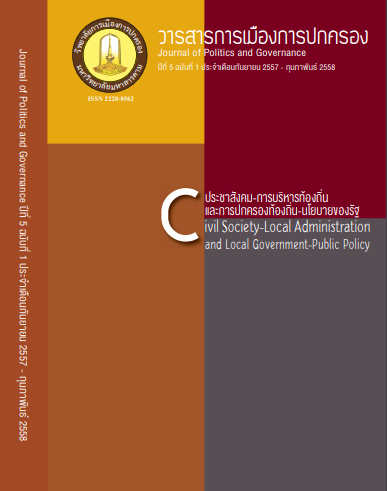The Problems of The Policy Implementation of Community Welfare Making Supportive of Community Welfare Funds in Muang District Areas, Mahasarakham Province
Main Article Content
Abstract
The government gives precedence to setting up the policy of the community welfare making supportive, and allocates the budget to the community welfare funds constantly 3 years since 2010 to 2012. The principles of the community welfare organization are to rely on one-self and to assist other people in the community. The purpose of this study is to study the opinions about the problems and suggestions for problem-solving in the policy implementation of the community welfare making supportive of the community welfare funds in Muang district areas, Mahasarakham province. The sample group of this study are the Committee of the Community Welfare Funds in Muang district areas, Mahasarakham province, consisting of 14 funds with 195 people who are defined by Taro Yamane’s formula, quota sampling, and convenience sampling respectively, and 7 key informants who were purposively selectedare the research instruments. The questionnaire and the semi-structured interview form. The data were analyzed and interpreted statistically in terms of frequency, percentage, mean, and standard deviation.
The results of the study revealed as follows:
1. The opinions about the problems in the policy implementation of the community welfare making supportive of the community welfare fund committee in Muang district areas, Mahasarakham province in overall and 5 perspectives the problems were at the moderate level sorted in descending order as: budget, location, equipment and utensils, personnel, and structure. The main problems were found that the funds couldn’t be granted from other sources of budget; that the funds lacked for the budget to construct the building; that the funds lacked for the updated information system to support the operation of community welfare funds; that the committee of the community welfare funds lacked of motivation; and that the local government organization didn’t appoint the officials for supporting the fund operation.
2. The suggestions for the policy implementation of the community welfare making supportive of the community welfare fund committee and key informants in Muang district areas, Mahasarakham province revealed that the related government agencies or organizations should define the scopes or guidelines for stipulating the distinct regulations of the community welfare funds as the operating guidelines; that the committee of the community welfare funds should be developed their potential, for examples being trained on the accurate accountancy regarding the accounting principles, defining the strategic plan, and making a tour of investigation in order to apply knowledge body to the community welfare funds efficiently; that the government should allocate the budget as the policy of the community welfare funds until the funds became autonomous; that the government should allocate the budget to the community welfare funds for constructing the office buildings since most of the funds lacked of their own offices; and that the fund should be trained on the computer applications and the updated information system and communication in order to apply knowledge to the fund operation, and to acquire timely information.
In conclusion, the policy implementation of the community welfare making supportive in Muang district areas, Mahasarakham province found that committee of the community welfare funds expressed the opinions about the operating problems in overall and each perspective at the moderate level. The policy of the community welfare making supportive was considered the satisfactory policy that benefited the fund members on basis of the community’s needs. According to the obtained information, it was practical for the committee of the community welfare funds as the information to develop the operation of the community welfare funds more qualitatively and effectively.
Article Details

This work is licensed under a Creative Commons Attribution-NonCommercial-NoDerivatives 4.0 International License.
References
กนกธร ละราคี. (2553). การประเมินผลการดำเนินงานกองทุนสวัสดิการชุมชนออมวันละ 1 บาท: กรณีศึกษา องค์การบริหารส่วนตำบลสายนาวัง อำเภอนาคู จังหวัดกาฬสินธุ์. วิทยานิพนธ์ รป.ม. สกลนคร: มหาวิทยาลัยราชภัฎสกลนคร.
กรมการปกครอง. (2556). ประกาศสำนักทะเบียนกลาง กรมการปกครอง เรื่อง จำนวนราษฎรทั่ว ราชอาณาจักร ณ วันที่ 31 ธันวาคม 2555.
กระทรวงการพัฒนาสังคมและความมั่นคงของมนุษย์. (2555). แผนยุทธศาสตร์กองทุนส่งเสริม การจัดสวัสดิการสังคม พ.ศ.2555-2559. กรุงเทพฯ.
บุญชม ศรีสะอาด. (2545). การวิจัยเบื้อง. กรุงเทพฯ: สุวีริยสาส์น.
ไพฑูรย์ ศรีละหว้า. (2553). การศึกษากองทุนสวัสดิการชุมชน กองทุนสัจจะออมวันละ 1 บาท: กรณีศึกษาตำบลบ้านกง อำเภอหนองเรือ จังหวัดขอนแก่น. การศึกษาอิสระ รป.ม. ขอนแก่น: มหาวิทยาลัยขอนแก่น.
ยุทธ ไกยวรรณ์ และ กุสุมา ผลาพรม. (2553). พื้นฐานการวิจัย. กรุงเทพฯ: ศูนย์สื่อเสริมกรุงเทพ.
ลัดดา ลาวรรณ. (2552). สภาพปัญหาการบริหารจัดการกองทุนสวัสดิการชุมชนขององค์การบริหารส่วนตำบลในเขตจังหวัดร้อยเอ็ด. การศึกษาค้นคว้าอิสระ รป.ม. มหาสารคาม: มหาวิทยาลัยมหาสารคาม.
วรเดช จันทรศร. (2548). ทฤษฎีการนำนโยบายสาธารณะไปปฏิบัติ. กรุงเทพฯ: สหายบล็อกและการพิมพ์ จำกัด.
สถาบันพัฒนาองค์กรชุมชน (องค์การมหาชน). (2552). คู่มือการดำเนินงานโครงการสนับสนุนการจัดสวัสดิการชุมชน. กรุงเทพฯ: โรงพิมพ์แอ๊ปป้าพริ้นติ้งกรุ๊ป.
สำนักงานพัฒนาสังคมและความมั่นคงของมนุษย์จังหวัดมหาสารคาม. (2556). รายงานผลการ ดำเนินงานโครงการสนับสนุนการจัดสวัสดิการชุมชนจังหวัดมหาสารคาม ปี 2555-2556. มหาสารคาม: อภิชาตการพิมพ์.


